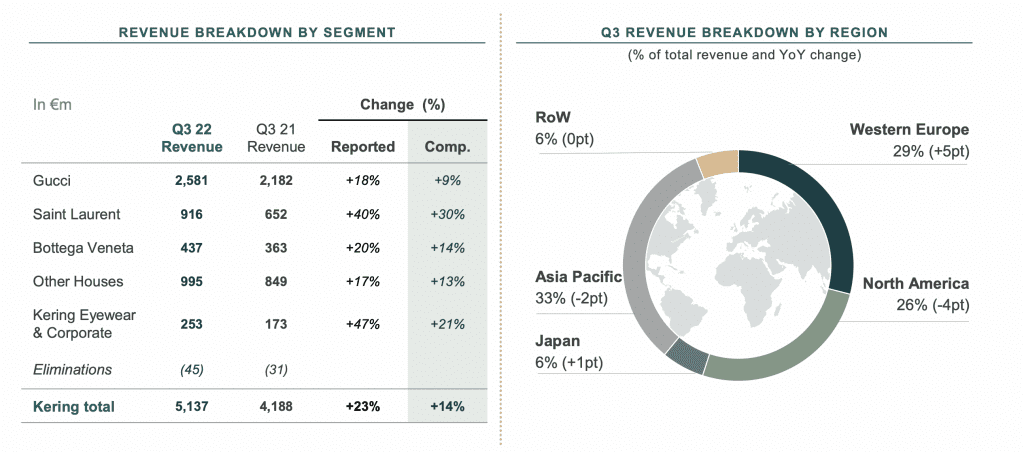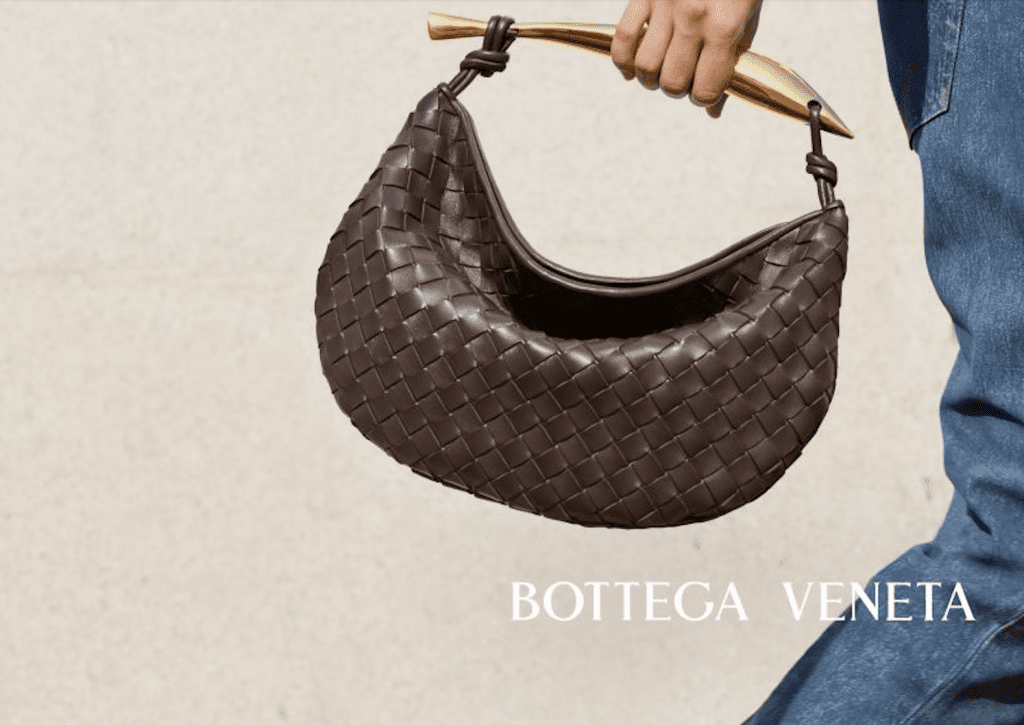Kering beat analysts’ expectations for revenue for the third quarter, reporting sales of 5.14 billion euros ($5.03 billion) for the three-month period ending on September 30, up 14 percent compared to the same period in 2021 (analysts anticipated 12 percent) and up 28 percent over pre-pandemic 2019. The Gucci, Saint Laurent, Bottega Veneta, and Balenciaga owner’s three-month gains were driven by sales growth in all regions, and a “hefty contribution” from American tourists banking on the strength of the dollar in Europe, the French luxury goods group revealed on Thursday. Sales at Kering’s marquee brand, Gucci rose by 9 percent during Q3, but that was not enough to match analysts’ expectations, which put a 11 percent figure on the brand’s sales growth.
Delving into its biggest brand, Kering reported that GUCCI generated revenue of 2.58 billion euros ($2.52 billion), up 9 percent on a comparable basis. “Sales generated in directly operated Gucci stores grew 9 percent on a comparable basis, [with] momentum remaining very strong in Western Europe, supported by both local customers and tourists, particularly from the U.S.,” per Kering. The flip side of luxury-shopping American tourists was that growth was muted in North America. Meanwhile, the brand’s performance in Mainland China was “mixed, impacting sales in Asia-Pacific, where overall trends posted a notable improvement.”
As for wholesale revenue for Gucci during Q3, that totaled 2 percent, and demonstrates that Kering’s effort to significantly rein-in wholesale channel activity for the brand is “now complete.”

More of a shining star from a growth perspective, Kering’s second-largest brand SAINT LAURENT boasted 30 percent comparable growth and 916 million euros ($896.4 million) in revenue. Sales in directly operated stores were up by 38 percent from Q3 2021, “driven by all product categories.” Revived tourism and desirability with local customers led to sales in Western Europe that were double those of Q3 2021, while Saint Laurent benefitted from a “sturdy performance in N. America, and strong growth in Asia Pacific and Japan.” On the product side, the brand reported high double-digit growth in all categories thanks to “existing products and very successful introductions.”
Wholesale here grew, per Kering, which cited demand for Saint Laurent’s Fall/Winter collection as driving wholesale revenue up by 13 percent on a comparable basis.
BOTTEGA VENETA revenue totaled 437 million euros ($427.7 million) for the third quarter, up 14 percent on a comparable basis. “Growth was driven by sales in directly operated stores, up 20 percent on a comparable basis, reflecting the excellent reception of Matthieu Blazy’s first collection” and “particularly remarkable” sales in Western Europe and Japan. The brand’s wholesale revenue fell 5 percent, in line with what Kering says is the “house’s strategy of streamlining this channel.”
As for Kering’s OTHER HOUSES, the largest of which are Alexander McQueen and Balenciaga, sales in the third quarter totaled 995 million euros ($973.7 million), an increase of 13 percent. Sales at Balenciaga and Alexander McQueen were “particularly buoyant across all product categories.”
Geographically speaking, Kering pointed to sales in Western Europe (up 74 percent) and Japan (up 31 percent) as “particularly outstanding,” while a small rise in North America market (up 1 percent) “reflects the high comparison base together with the hefty contribution from American tourists to European sales momentum.” Still yet, growth in Asia Pacific (up 7 percent) was “robust,” despite the impact of Covid restrictions in Mainland China.
THE BIG(GER) PICTURE
Reflecting on Kering’s results, Jefferies’ analysts Flavio Cereda and Kathryn Parker states that Gucci –whose “shortcomings are more obvious” – is still in “an odd limbo as it seeks to regain brand appeal, but China is not helping and this is not changing anytime soon.” The brand, which generates almost half of the group’s revenue, “needs a trend reversal with some urgency, yet we fail to see how in the short term.”
Meanwhile, in a separate note, Bernstein analysts pointed to Kering management’s focus on Gucci’s newly-appointed design and China management team, which have a brand “elevation plan” in place, with three focus areas: (1) Gucci’s return to the fashion calendar with six collections in 2023; (2) Expansion of Gucci into the high-end offer, which is a priority; and (3) The men’s and travel category expansion where they have not yet reached the full potential.
And still yet, in a Q3 call with analysts on Thursday, which largely focused on the slowdown of Gucci and the success of Saint Laurent, Kering’s management provided some interesting insight about its trademarks in Russia. CFO Jean-Marc Duplaix revealed that the group is “taking time to assess the situation” in Russia, noting that it is “not a very simple question.” The group has “strictly applied the [sanctions] rules,” and closed all of its stores in Russia (a “few” Gucci outposts and one Boucheron) in early March, with Duplaix saying that even before the closures, Kering did “not have a huge exposure to Russia, and especially not through direct operations.”
The group will continue to monitor the situation and is prepared to take some decisions “if needed,” per Duplaix, “considering also that we need to protect our brand and trademarks in the country.” This requires a “presence in the country,” where Kering is currently still paying rent for its stores and paying employees, and so, Kering will measure the “best balance” even if they do not expect to be able to operate in the country again in the “short term or mind term.”











